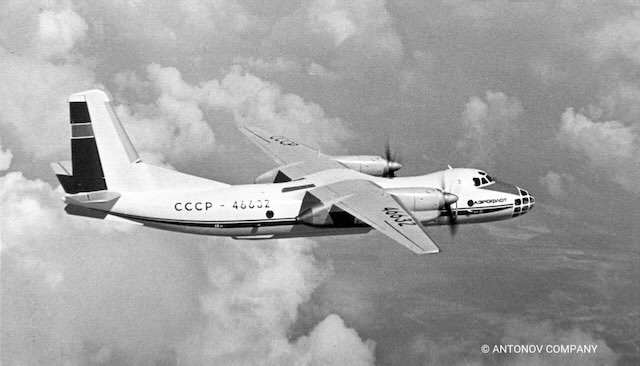An-30 Clank
Summary
| Category | Military Transport Aircraft |
| Origin country | 🇺🇦 Ukraine |
| Manufacturer | Antonov |
| First flight | 27 August 1967 |
| Year introduced | 1968 |
| Number produced | 123 units |
| Average unit price | $7 million |
Description
The Antonov An-30 is a development of the An-24, initially conceived as an aerial survey aircraft. The first aerial survey version of the An-24 was designed by the Beriev OKB and designated An-24FK (fotokartograficheskiy, meaning photo mapping). The prototype was converted from a production An-24A at Beriev's No. 49 construction shop during 1966, with its first flight on August 21, 1967. State acceptance trials were completed in 1970, and civil certification in 1974. Subsequently redesignated as the An-30, production commenced in 1971 at the Antonov factory, resulting in 123 aircraft manufactured in Kiev between 1971 and 1980 in two main versions.
The Antonov An-30, a specialized variant of the An-24, distinguishes itself through a redesigned forward fuselage. The most prominent feature is the extensively glazed nose, which houses the navigator and precision navigational equipment, including an optical sight. The flightdeck is raised by 41 cm, creating a distinctive hump that provides clearance for the mission equipment. This equipment includes computer flight path control technology to ensure the accuracy required for aerial photography, a function which supplants the radar found on the base An-24. The main cabin contains five camera windows in the floor, each with protective covers. In a typical aerial photography configuration, the aircraft carries four to five cameras, including three vertical for mapping and two oblique cameras angled at 28° for lateral photography, all of which can be utilized at altitudes between 2,000 and 7,000 meters. The An-30 is powered by two Ivchenko AI-24VT turboprops.
While primarily designed for aerial cartography and survey missions, some An-30 variants were adapted for specialized roles which influenced their loadout. The An-30M "Meteozashchita" variant, for example, could be equipped for weather research, replacing photographic equipment with eight containers each holding 130 kg of dry ice for cloud seeding. Additionally, some An-30B models were retrofitted with chaff/flare dispensers, and the An-30R variant was converted into an NBC reconnaissance aircraft, equipped with air-sampling pods under the forward fuselage and sensors for detecting nuclear, biological, and chemical warfare by-products. One An-30R was even outfitted with pylons for dropping large flare bombs. The An-30 has served in various roles beyond its primary function as a survey aircraft. It has been utilized by countries such as Bulgaria, Czech Republic, Romania, Russia, and Ukraine for surveillance missions under the Open Skies Treaty. The An-30 has been adapted as a weather control aircraft, designated as the An-30M, with some equipped with tanks of frozen carbon dioxide for cloud seeding to induce artificial rain or prevent crop-damaging hailstorms. Between 1971 and 1980, a total of 115 aircraft were manufactured, with 23 being exported to countries including Afghanistan, Bulgaria, China, Cuba, Czechoslovakia, Mongolia, and Vietnam. An-30s were deployed to completely map Afghanistan in 1982, with one being shot down by a MANPADS in 1985. Cuban An-30s also saw active service in Angola in 1987. In more recent conflicts, a Ukrainian An-30 sustained damage from small-arms fire in 2014 while conducting surveillance over Sloviansk, and another was shot down near Slavyansk the same year, reportedly by a MANPADS.
Main Variants:
-
An-24FK: The initial aerial survey version, converted from an An-24A, featuring photo mapping capabilities.
-
An-30A: The civilian aviation version, designed for use by the Soviet Ministry of Civil Aviation and for export, with a focus on cartography and aerial survey tasks.
-
An-30B: The version designed for the Soviet Air Force, differing from the An-30A primarily in its avionics fit, with many examples later retrofitted with chaff/flare dispensers.
-
An-30D Sibiryak: A long-range variant of the An-30A with increased fuel capacity, utilized for tasks such as ice and fisheries monitoring, as well as transport, featuring improved communication and rescue equipment.
-
An-30M Meteozashchita: A weather research version equipped to spray dry ice into the atmosphere for weather control duties, replacing photographic equipment with dry ice containers.
Technical specifications
| Version: An-30B | |
|---|---|
| Maximum speed | 540 km/h (336 mph) |
| Wing area | 75 m² (807.3 sqft) |
| Wingspan | 29.2 m (95.8 ft) |
| Height | 8.3 m (27.3 ft) |
| Length | 24.3 m (79.6 ft) |
| Service ceiling | 8,300 m (27,231 ft) |
| Empty weight | 15,590 kg (34,370 lbs) |
| Max. takeoff weight | 23,000 kg (50,706 lbs) |
| Powerplant | 2 x turboprops Ivchenko-Progress AI-24T delivering 2074 kW each |
All operators





